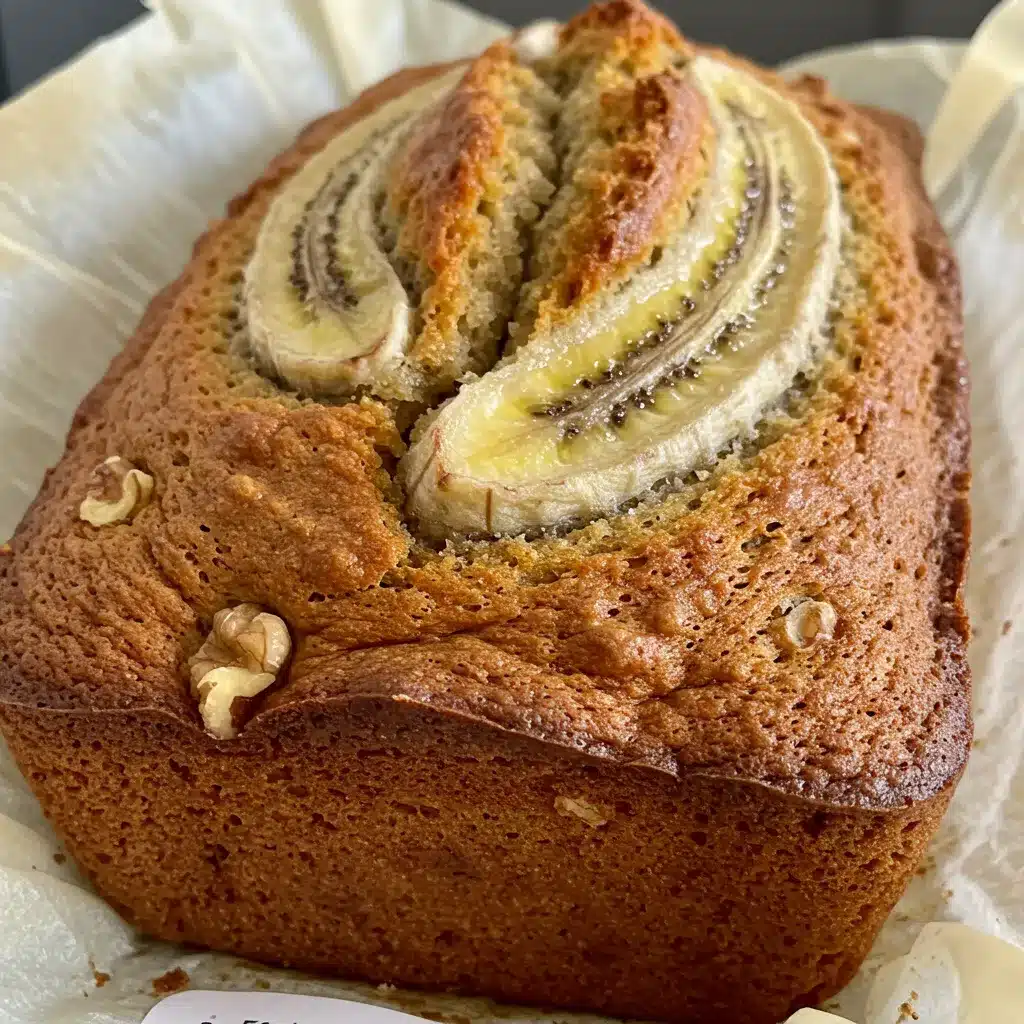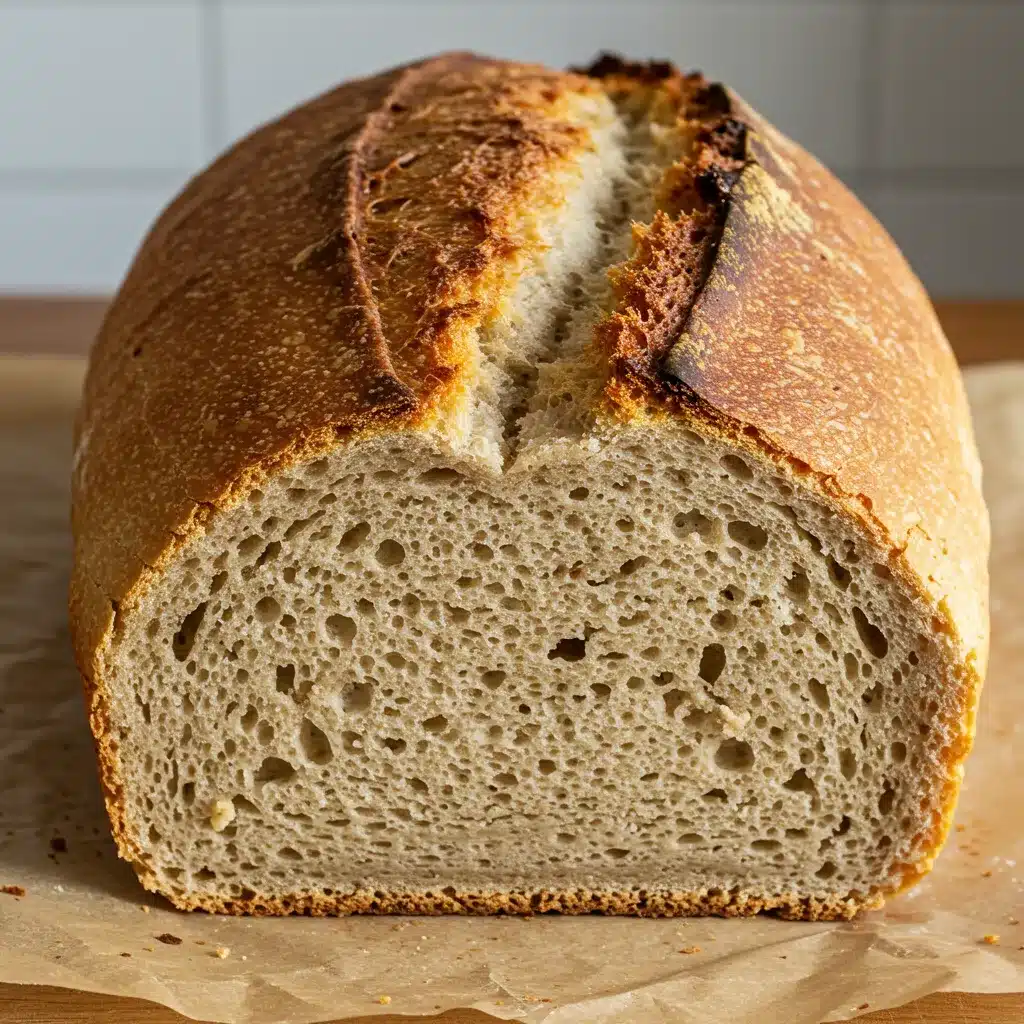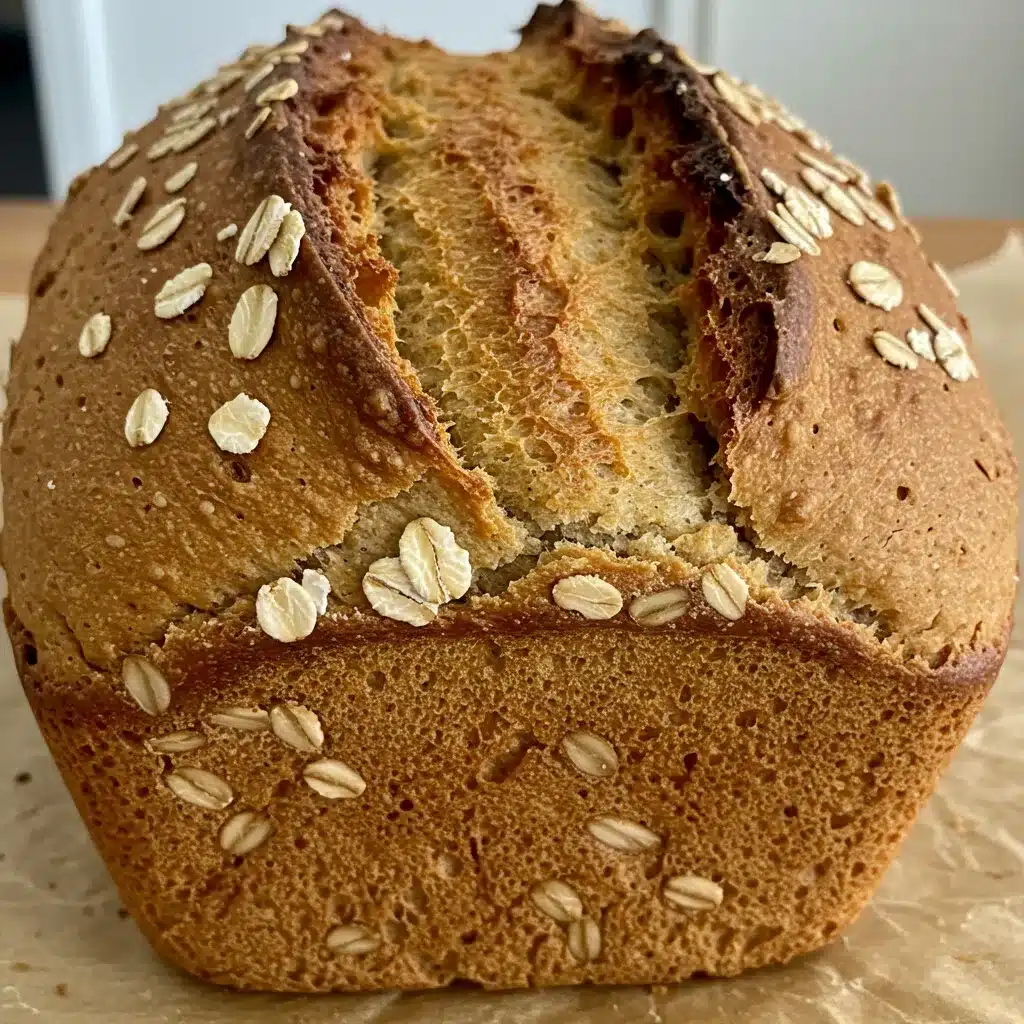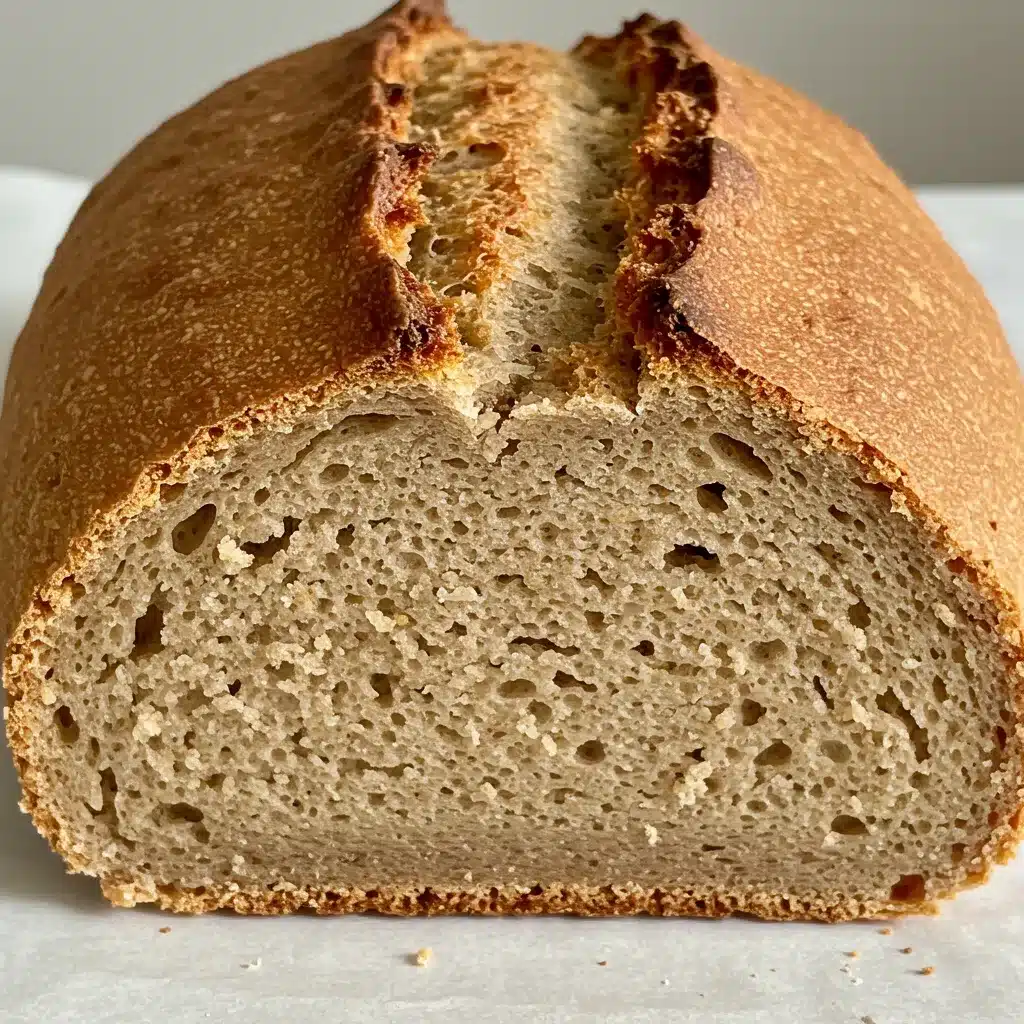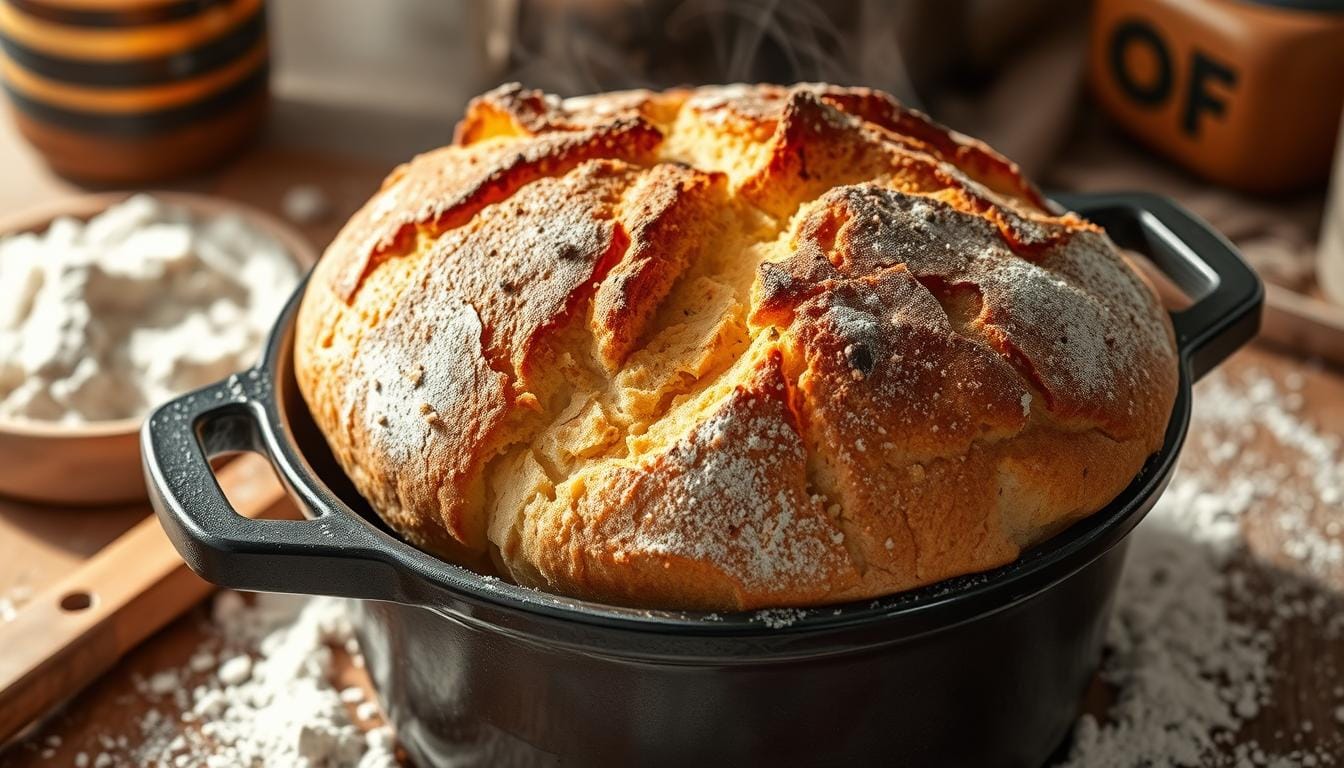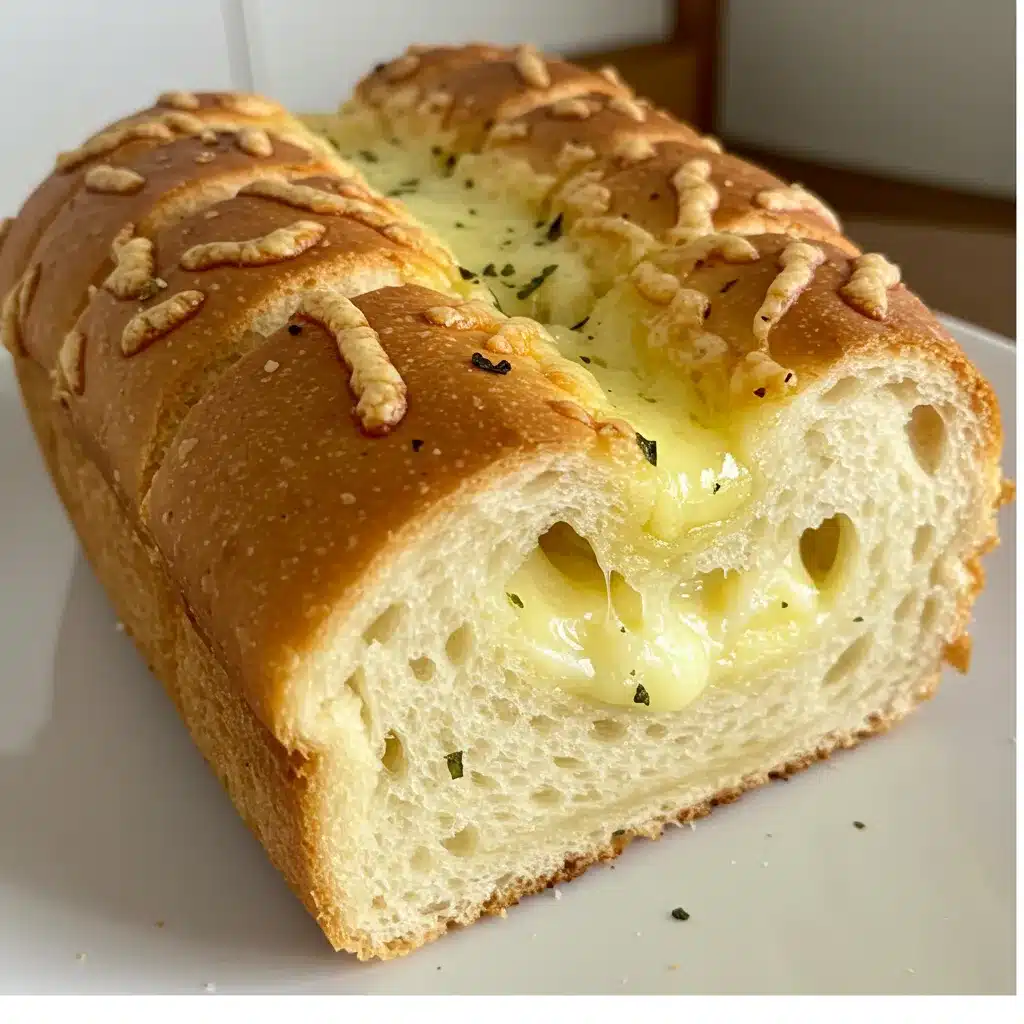Adding Vanilla Quick Bread Recipe: What Happens in Baking?
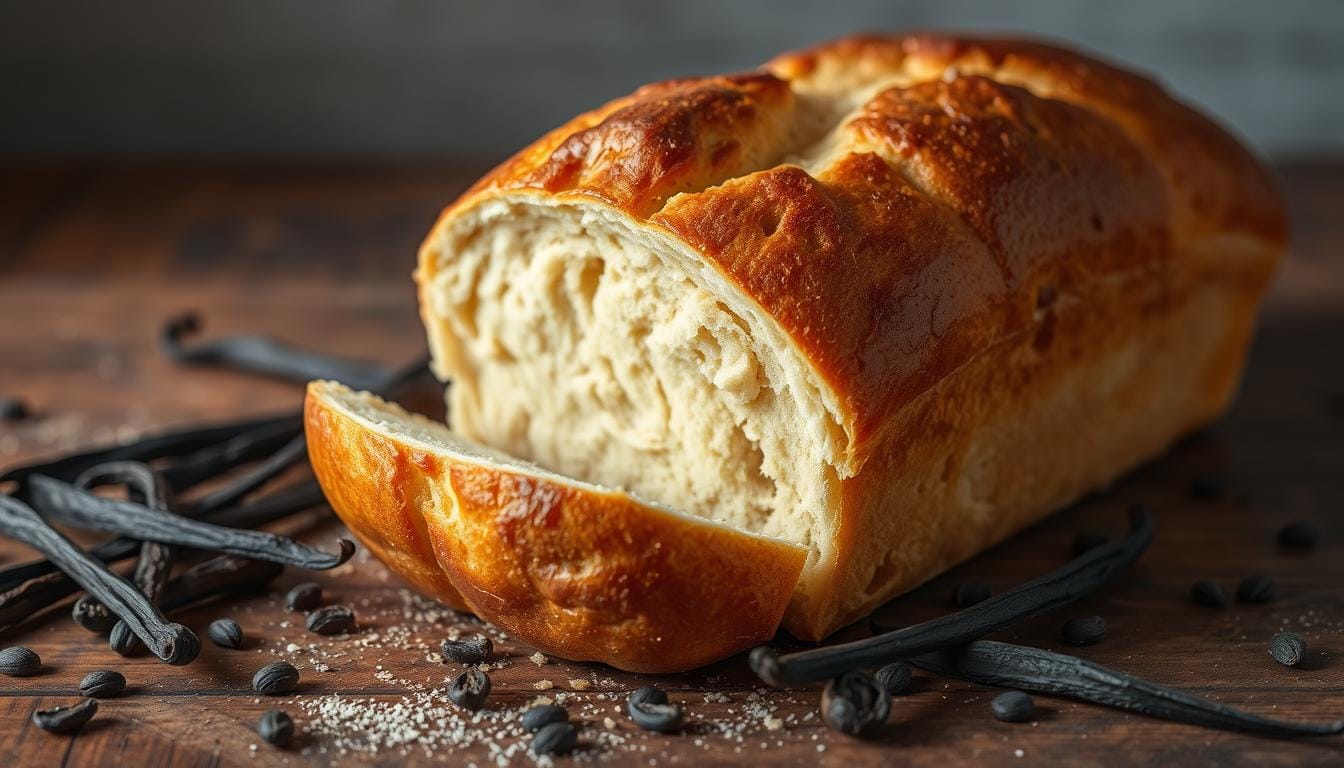
The smell of freshly baked bread brings back happy memories. It’s a scent that feels like coming home. What if you could make this classic bread even better with a special ingredient? Vanilla, often found in sweet treats, can also make savory breads special.
I’ve always been curious about adding vanilla to my bread. Would it change the taste too much, or would it blend in perfectly? Let’s find out how vanilla can change bread recipes.
Table of Contents
Understanding the Role of Vanilla in Bread Making
Vanilla is a favorite ingredient in many recipes, but it’s not just for cakes and cookies. Adding vanilla extract in bread can change the flavor in amazing ways. By learning how vanilla affects baking, bakers can make their bread even more delicious.
Traditional Vanilla Uses in Baking
Vanilla is known for adding warmth and a hint of sweetness to baked goods. Its unique flavor can tie together different tastes, making recipes more balanced. This is why it’s a key ingredient in treats like cakes and cookies.
Benefits of Adding Vanilla to Bread
Adding vanilla extract in bread brings many benefits. It adds a comforting aroma and a bit of sweetness. This can make the bread’s flavor more balanced and sophisticated.
How Vanilla Influences Bread Character
Vanilla does more than just add sweetness to bread. It can bring together complex flavors, creating a harmonious taste. The enhancing bread flavor vanilla provides can make even simple bread feel special.
“The addition of vanilla can truly transform a simple vanilla quick bread recipe into something extraordinary, elevating the overall experience for both the baker and the lucky recipient.”
The Science Behind Vanilla’s Chemical Composition
Vanilla is more than just a flavoring in baking. Its chemical makeup is key to the texture, aroma, and taste of breads. The compounds in vanilla interact with gluten, which can change the bread’s texture.
But, vanilla doesn’t stop yeast from making the bread rise. The heat during baking releases the aroma of vanilla, making the bread smell and taste better. This is because the heat spreads the flavor molecules throughout the bread.
Exploring vanilla’s baking chemistry is important. Vanilla beans have many vanilla compounds that mix with other ingredients in dough. This creates a mix of flavors that excites the senses.
“Vanilla is the most popular ice cream flavor in the United States.”
When bread bakes, heat starts chemical reactions that release these scents. This makes the flavor molecules and aroma spread through the bread. It gives a wonderful taste and smell to the consumer.
Knowing how vanilla works in baking lets bakers make bread that looks good and tastes amazing. It’s all about the science behind vanilla’s flavor.
What Happens if I Add Vanilla to a Bread Recipe
Adding vanilla to your bread dough can lead to interesting changes. These changes happen right away and as the bread bakes. Let’s see how vanilla affects your final loaf.
Immediate Effects on Dough
Vanilla, especially vanilla extract with alcohol, can make your dough slightly wetter. This might make the dough seem sticky or soft at first. But, this small change is easy to fix by adjusting the dough’s moisture level.
Changes During Baking Process
As your bread bakes, the heat brings out the vanilla’s scent. Your kitchen will fill with a warm, inviting smell. This scent adds a sweet and deep flavor to your bread without making it too sweet.
For richer breads like brioche, vanilla makes the bread soft and delicate. It matches well with the dough’s richer ingredients.
Final Flavor Profile
Adding vanilla to your bread recipe enhances its flavor subtly but noticeably. Vanilla blends well with other ingredients, making the taste more complex and balanced. This is especially good in sweet or semi-sweet breads, where vanilla boosts the sweetness.
It’s important to use vanilla wisely, as too much can dominate other flavors. Try different amounts and types of vanilla to find the right balance for your recipe.
Types of Vanilla Products for Bread Baking
There are many ways to add vanilla to your bread. Vanilla extract is easy to use and tastes great. But, vanilla beans give a deeper flavor. Vanilla powder is good for recipes that need a light touch.
Pure vanilla is best for real flavor. But, imitation vanilla is cheaper and works well in big amounts. It’s all about finding the right amount of vanilla to match your bread.
| Vanilla Product | Flavor Intensity | Best Uses | Price Range |
|---|---|---|---|
| Vanilla Extract | Moderate | Most bread recipes | $6-$12 per 4 oz bottle |
| Vanilla Beans | Strong | Sweet breads like challah, brioche | $2-$6 per bean |
| Vanilla Powder | Subtle | Delicate bread recipes | $8-$15 per 4 oz jar |
Choosing the right vanilla depends on your recipe’s flavor and character. Vanilla beans are for those who want a bold taste. Vanilla powder is for recipes that need a light touch. Vanilla extract is versatile and works in many breads.
“Vanilla is a rare ingredient in bread recipes, but sweet breads like brioche and challah have started to include it to enhance the overall flavor without making it overly sweet.”
Measuring and Timing: When to Add Vanilla
Adding vanilla to bread can greatly improve its taste. The right amount and timing are key. The amount of vanilla needed depends on the bread type and the flavor you want.
Proper Measurements for Different Bread Types
Begin with half a teaspoon of vanilla extract per loaf. Adjust this based on how sweet the bread is. Sweeter breads can handle a bit more vanilla.
For savory breads, use less vanilla. This adds depth without changing the bread’s taste.
Optimal Mixing Stages
Put the vanilla in early, during the first mix or knead. This spreads the flavor evenly. It’s important to measure carefully to keep the flavors balanced.
“The key to successfully incorporating vanilla into bread is finding the right balance. Start with a small amount and adjust to your taste preferences.”
Knowing how to measure and when to add vanilla can make your breads better. It brings out the best in your homemade bread.
Impact on Bread Texture and Crumb Structure
Vanilla’s effect on bread texture and crumb structure is subtle yet significant. It doesn’t change bread’s density much. But, it can make the crumb in enriched breads soft and delicate.
Vanilla helps keep bread moist and soft as it bakes. This makes the crumb tender and light. The texture becomes more enjoyable to eat.
Adding vanilla can also make bread’s texture better. It creates a softer, fluffier crumb. This is great for richer breads where a soft crumb is key.
| Bread Characteristic | Effect of Vanilla |
|---|---|
| Texture | Improved softness and tenderness |
| Crumb Structure | Subtle changes, maintains lightness and airiness |
| Moisture Retention | Enhanced, keeping bread fresh for longer |
Vanilla lets bakers make breads with a wonderful texture and crumb. These breads are a treat for the senses.
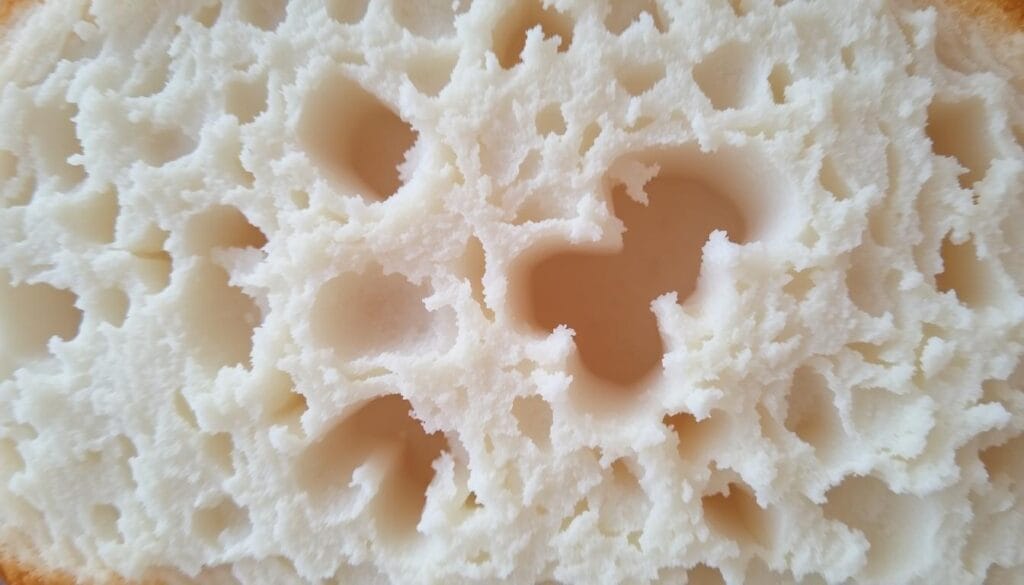
Flavor Enhancement and Aroma Development
Adding vanilla to your bread recipe is where the magic begins. As the bread bakes, chemical reactions release vanilla’s aromatic compounds. This intensifies its aroma and boosts the bread’s flavor.
These reactions create a rich scent that fills the air. It makes the freshly baked bread even more tempting.
Chemical Reactions During Baking
The oven’s heat is what drives these chemical changes. It spreads vanilla’s flavor evenly, blending it with other ingredients. This creates a balanced and complex taste in the bread.
Aromatic Compounds Release
Vanilla’s flavor comes from aromatic compounds like vanillin. These compounds are released when heated, filling the bread and the air with their scent. It’s a treat for both the baker and those who get to enjoy the bread.
“The aroma of freshly baked bread with vanilla is one of the most comforting and inviting scents imaginable. It’s a sensory experience that can instantly transport you to a cozy kitchen.”
Understanding how vanilla interacts with baking can enhance your bread’s flavor and aroma. The chemical reactions and release of aromatic compounds improve the overall taste of your baked goods.
Vanilla’s Effect on Bread Moisture Content
Vanilla’s role in baking bread is more complex than you might think. Vanilla extract has a small amount of alcohol, but it doesn’t greatly affect bread moisture. In fact, vanilla can help keep your bread soft for longer.
The vanilla extract effects on baking moisture come from its chemical makeup. Vanilla’s aromatic compounds boost the bread’s flavor. They also help make the bread’s crumb tender. This is because vanilla interacts with flour and eggs during baking.
The exact effect of vanilla on bread moisture depends on the recipe and type of vanilla used. Vanilla extract might have a stronger effect than vanilla powder or bean paste. But the difference is usually small and won’t change the bread’s texture much.
Vanilla does help keep bread moist, but it’s not the main factor in texture. To get the perfect bread, focus on the right ingredients, mixing, and baking times and temperatures. This way, your bread will be moist and delicious.
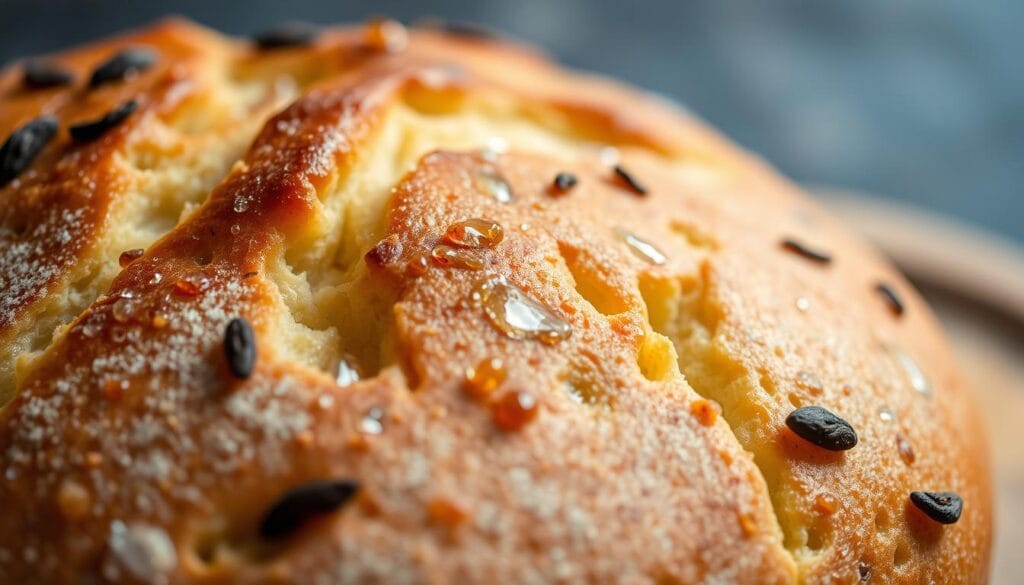
Combining Vanilla with Other Bread Ingredients
Creating tasty bread recipes is all about mixing flavors. Vanilla’s rich, aromatic taste blends well with many ingredients. This makes your baked goods even more delicious. From bread flavor combinations to spice pairings, vanilla is incredibly versatile.
Complementary Flavors
Vanilla pairs well with spices like cinnamon and nutmeg, adding a cozy flavor. It also balances the sweetness of honey and maple syrup. For chocolate or fruit lovers, vanilla enhances their flavors in vanilla recipes.
Spice Combinations
- Cinnamon and Vanilla: A classic pairing that adds warmth and depth to breads, pastries, and even savory dishes.
- Nutmeg and Vanilla: The subtle sweetness of nutmeg pairs exceptionally well with the creamy essence of vanilla.
- Cardamom and Vanilla: An unexpected but delightful combination that can transport your bread flavor combinations to new heights.
In savory breads, a hint of vanilla adds depth without making it too sweet. This makes it perfect for trying mixed flavor profiles. The options are endless with spice pairings and bread flavor combinations that use vanilla.
Best Vanilla Quick Bread
Some breads are better than others when it comes to vanilla. Brioche is a top choice. It’s rich and buttery, making a sweet and fluffy loaf.
Sweet breads like challah or cinnamon rolls also love vanilla. The smell of vanilla coming from the oven is amazing.
Quick breads like banana or pumpkin bread get a boost from vanilla. It adds sweetness and depth, making the bread more satisfying.
Even gluten-free bread recipes can be improved with vanilla. It adds richness and complexity, making the bread more flavorful.
“Vanilla’s versatility shines in a wide range of bread recipes, from classic enriched doughs to sweet quick breads. Its ability to enhance and complement a variety of flavors makes it an essential ingredient in the baker’s toolkit.”
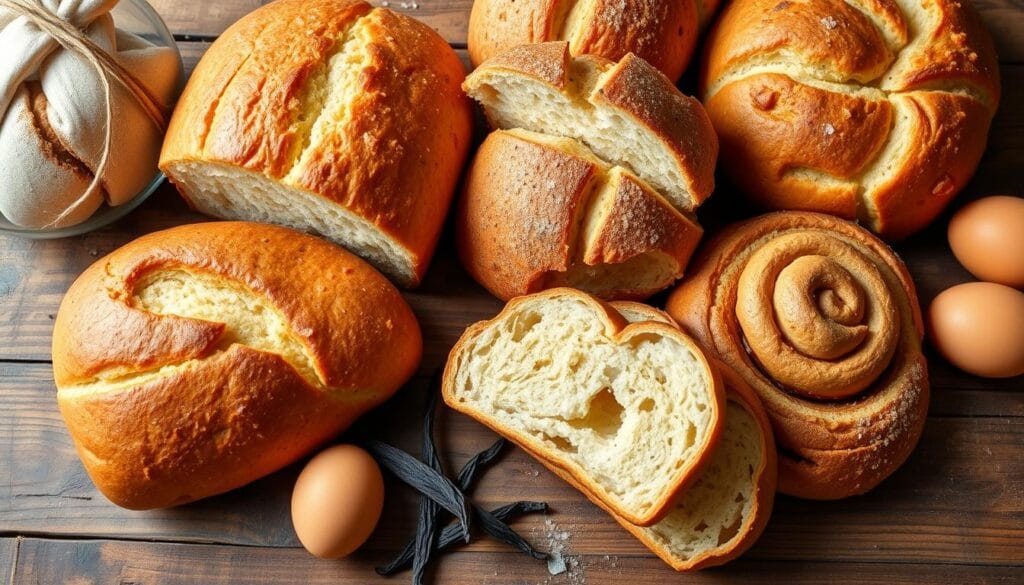
Adding vanilla to your baking can make a big difference. It’s great in brioche, challah, or banana bread. It brings out new flavors and aromas, making your vanilla bread recipes even better.
Effects on Yeast Activity and Fermentation
Adding vanilla to your bread recipe won’t mess with yeast activity. The bread fermentation process stays the same. You usually won’t need to change the rising time. But, you might need to add a bit more flour to keep the dough right.
Fermentation Process Changes
Vanilla in your dough won’t change how yeast works. The yeast will still make carbon dioxide and help the dough rise. You’ll get the same good results with vanilla in your bread.
Rising Time Adjustments
You usually don’t need to change the rising time with vanilla in dough. The little liquid from vanilla won’t mess with the dough’s moisture or yeast’s work. But, watch the dough and add flour if it gets too wet or sticky.
Knowing how vanilla affects bread fermentation and yeast activity lets you add this flavor to your baking easily. With a few tweaks, you can enjoy vanilla’s aroma and taste in your fresh bread.
Color Changes and Crust Development
Adding vanilla to your bread recipe can cause some color changes. Vanilla, especially in extract form, can make the crust browner. This results in a richer, more golden look that makes the bread more appealing.
The effect on the crust is usually small. But, the vanilla can make the crust taste and smell better. The color change is subtle, but it adds depth and interest to your bread.
It’s worth noting that vanilla’s impact on color is small compared to other factors. Things like flour type, baking temperature, and time can affect the crust more. Still, vanilla’s flavor and slight color change can make your homemade bread even better.
FAQ
What happens if I add vanilla to a bread recipe?
Adding vanilla to bread adds a special flavor layer, usually found in desserts. It makes a simple loaf into something unique. The aroma of vanilla makes each bite more enjoyable.
Vanilla enhances the flavor without making it too sweet. It blends well with the bread’s natural taste.
How does vanilla typically influence bread character?
Vanilla brings sweet, floral notes and a comforting aroma to bread. It helps balance complex flavors, creating harmony in recipes.
What are the benefits of adding vanilla to bread?
Vanilla adds warmth, complexity, and a hint of sweetness to bread. It enriches the flavor without overpowering the bread’s taste.
How does the chemical composition of vanilla affect bread baking?
Vanilla’s compounds interact with gluten proteins, possibly changing texture. Heat releases vanilla’s aroma and flavor during baking, enhancing the bread.
How can different forms of vanilla impact bread flavor?
Vanilla’s intensity varies by form. Vanilla extract is common, while vanilla beans offer a stronger flavor. Vanilla powder is subtle, perfect for delicate recipes.
How much vanilla should I add to my bread recipe?
Start with half a teaspoon of vanilla extract per loaf. Adjust to taste. In sweeter breads, more vanilla is okay. For savory breads, use less to add depth.
How does vanilla affect the texture and crumb structure of bread?
Vanilla doesn’t change bread density much. But, it can make enriched breads soft and delicate. Vanilla’s moisture retention helps keep bread moist.
How does vanilla impact the baking process and final flavor profile?
Baking releases vanilla’s aromatic compounds, intensifying its scent and flavor. These reactions create a rich, inviting aroma, making the bread more appealing.
What types of breads work best with added vanilla?
Vanilla is great in enriched breads like brioche, making them fluffy and aromatic. It’s also perfect for sweet breads like challah or cinnamon rolls, blending well with sweet ingredients.
Does vanilla interfere with yeast activity or the bread’s rise?
Vanilla doesn’t affect yeast activity, so it won’t change the bread’s rise. The fermentation process remains the same when vanilla is added.

